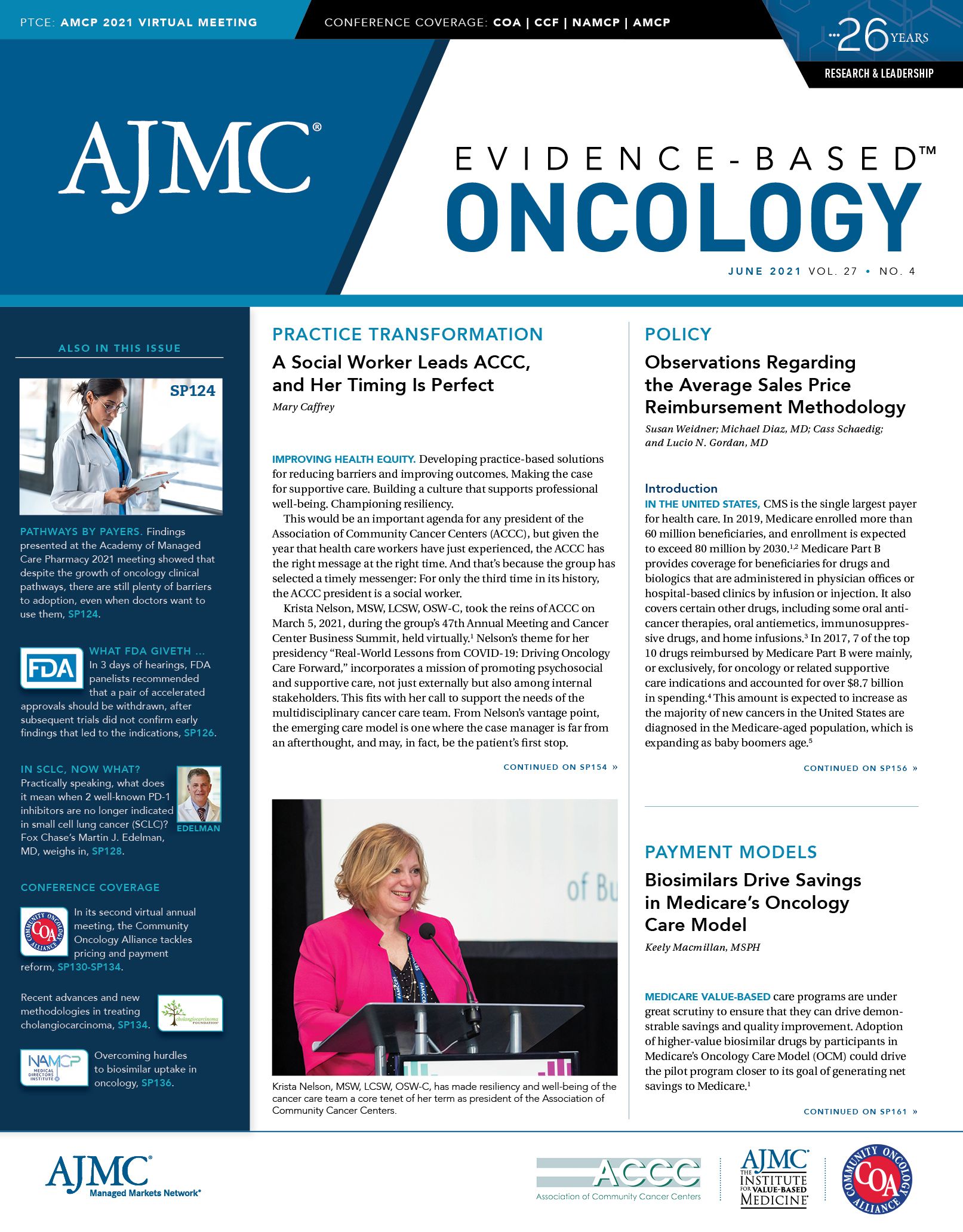- Center on Health Equity & Access
- Clinical
- Health Care Cost
- Health Care Delivery
- Insurance
- Policy
- Technology
- Value-Based Care
Observations Regarding the Average Sales Price Reimbursement Methodology
Introduction
In the United States, CMS is the single largest payer for health care. In 2019, Medicare enrolled more than 60 million beneficiaries, and enrollment is expected to exceed 80 million by 2030.1,2 Medicare Part B provides coverage for beneficiaries for drugs and biologics that are administered in physician offices or hospital-based clinics by infusion or injection. It also covers certain other drugs, including some oral anticancer therapies, oral antiemetics, immunosuppressive drugs, and home infusions.3 In 2017, 7 of the top 10 drugs reimbursed by Medicare Part B were mainly, or exclusively, for oncology or related supportive care indications and accounted for over $8.7 billion in spending.4 This amount is expected to increase as the majority of new cancers in the United States are diagnosed in the Medicare-aged population, which is expanding as baby boomers age.5
Medicare Part B Reimbursement Methodology
Medicare Part B provides reimbursement at a rate of the average sales price (ASP) plus a 6% add-on fee (ASP 6), a methodology that relies on market-based prices to set reimbursement rates.6 The 6% is provided as an add-on payment to cover expenses related to the needs of physician-administered drugs. Among these are purchasing variability, shipping fees, complex administration, ongoing patient monitoring and education, and overhead for storage and handling requirements.7,8
ASP was enacted in 2005 as part of the Medicare Prescription Drug, Improvement, and Modernization Act of 2003 and generally reflects the average price of a drug’s sales to all purchasers in the United States, including commercial payers. The ASP is calculated for each Healthcare Common Procedure Coding System (HCPCS) code included in Part B coverage with a 2-quarter lag, as shown in Figure 1. HCPCS codes may include drugs from a single source or, more commonly, from more than 1 manufacturer. Drug manufacturers provide data for the calculation to CMS quarterly.6
Figure 1.
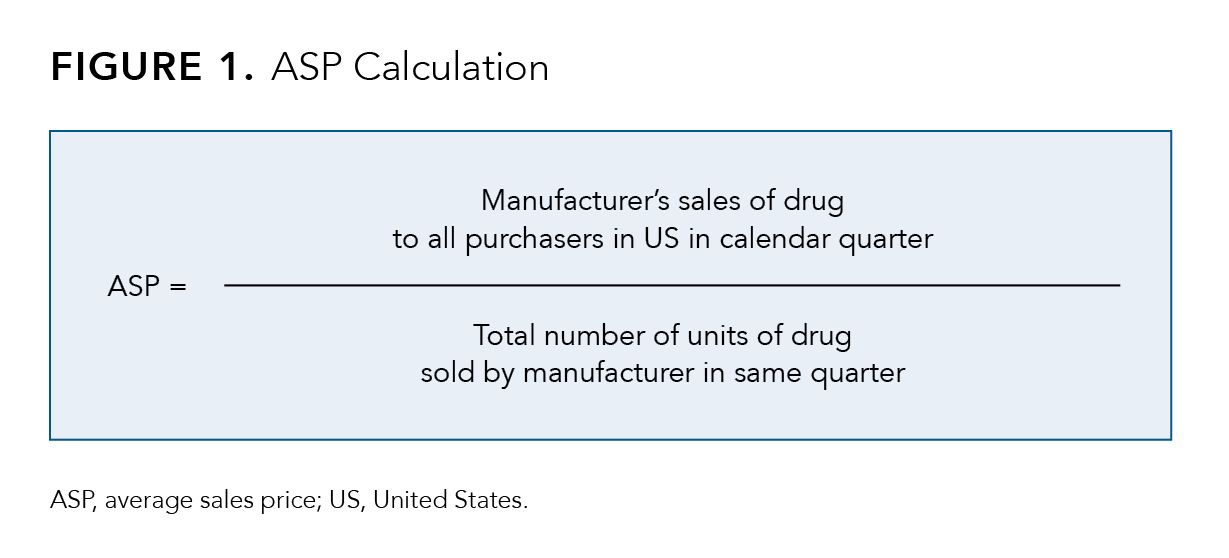
As HCPCS codes frequently include drugs from multiple manufacturers, ASP 6 provides reimbursement at 106% of the blended ASP for all products within an HCPCS code on a volume-weighted basis. Payment for a single-source drug with a unique HCPCS is, in general, based upon either 106% of the ASP or 103% of the wholesale acquisition cost (WAC), whichever is lower.7,9
When reporting price, manufacturers must account for concessions, including volume discounts, prompt-pay discounts, cash discounts, free goods contingent on any purchase requirement, chargebacks, and rebates.6
Due to additional legislation via the Budget Control Act of 2011 and the Balanced Budget and Emergency Deficit Control Act beginning in 2013, the actual Medicare Part B reimbursement to providers effectively became ASP plus a 4.3% add-on fee (ASP 4.3). This legislation required payment reductions in federal expenses through a sequestration order. The effects of sequestration on Part B drug reimbursement resulted in a drop in ASP from 6% to 4.3% and in WAC from 3% to 1.35%. This, in turn, resulted in the reimbursement methodology currently in use for Medicare Part B. Additionally, due to a known error surrounding prompt-pay discounts provided to distributors but not passed on to providers, actual realized reimbursement is likely closer to ASP plus 2.3%.
Issues Facing Medicare Part B Reimbursement
Despite a paucity of published data, the Medicare Payment Advisory Commission (MedPAC) provided a report to Congress in 2017 detailing their concerns with ASP, which included a lack of competition creation and the potential for incentivizing providers to choose higher-priced drugs.10 Additionally, Ridley et al recently published a conceptual model showing that launch prices have increased under this reimbursement model due to its reliance on lagged pricing.11 These publications maintain the perception that physicians are incentivized and driven by increased prices of drugs and that higher prices indicate higher profit and margin. In this review, we will explore recent literature that provides evidence directly contradicting these concerns.
In 2018, President Trump’s administration proposed American Patients First: The Trump Administration Blueprint to Lower Drug Prices and Reduce Out-of-Pocket Costs (Trump Blueprint). This proposed policy included aggressive concepts such as new negotiation tactics for Part B drug prices, movement of some drugs covered under Part B to Part D to allow for formulary management and utilization review, reimbursement for therapies based on their indication, an international pricing index (IPI), flat administration reimbursement, and higher prices for therapies when used off -label, among others.12,13 The impact of this policy on the ability of community
oncology practices, where the majority of patients receive their anticancer care, to continue to provide optimal care to patients—with potential reductions in reimbursement—is concerning.
As part of the Trump Blueprint, reimbursement could have changed to a flat fee add-on payment rather than a percentage-based add-on payment.14 The addition of the percentage-based add-on payment in the Medicare Modernization Act, was intended to ensure that providers are reimbursed for overhead costs, such as proper storage of medications, compounding compliance, and sdministration of complex regimens, among others.15 However, flat fee add-on payments are highly unlikely to capture all the nuances and complexities of cancer care. A flat fee is not dynamic, meaning it cannot reflect market and inflationary pressures and does not account for multidrug, complex treatment regimens or the administration of necessary supportive care medications.15 This proposed change in add-on fee structure could result in inconsistencies in reimbursement for any site of service and eventually prevent the delivery of proper care as far as treatment selection. It also would restrict access to care, as it would likely disproportionately affect vulnerable smaller practices in rural locations or underserved areas.
In a volatile political environment with potential policy changes that could affect more than 60 million Americans, it is important to understand the basis of the current Part B reimbursement system and the current benefits of ASP that would be imperative to preserve for future success. Herein, we aim to review ASP in the context of oncology therapies and provide comments on its methodology, as well as present our research on alternative models that may be employed in the future to ensure sustainable oncology practices.
Discussion
Before the introduction of Part B ASP reimbursement in 2005, Medicare used an average wholesale price (AWP) methodology with which providers were reimbursed at a rate of 95% of the AWP. AWP was a manufacturer’s suggested list price, which did not have to correspond to a market-based transaction price and did not reflect price discounts. Consequently, expenditures for Medicare Part B grew more than 25% per year from 1998 to 2003, and a report from the Government Accountability Office noted that Medicare payment rates under the AWP methodology consistently were well above providers’ acquisition costs. For this reason, the transition to the ASP methodology in 2005 represented a vast improvement in Part B reimbursement, with rates much closer to actual acquisition costs.16
Impact on Pricing and Reimbursement Trends
ASP PAYMENT METHODOLOGY MODULATES MACRO SPENDING TRENDS. Studies evaluating diverse aspects of the cost of cancer care, the impact of physician-incentive models, or value formulations are difficult to conduct; however, literature on ASP methodology indicates that the driving force in product selection is clinical effectiveness. Data suggest that ASP has lowered drug prices, reduced variation around drug pricing, limited year-over-year price increases, reduced chemotherapy treatment within 14 days of death, and discouraged the use of higher-priced drugs.17-28
Additionally, ASP has lowered overall Part B drug spending. As noted above, before ASP, Part B drug spending was rising at an average of 25% per year. Under ASP, that rate dropped to just 4.4% per year and, after adjusting for inflation, drug spending rose from 2007 to 2013 at an annual rate of 2.8% for all Part B drugs.26 Despite the entrance of numerous expensive biologics and targeted therapies, the total payments, number of units, and weighted ASP remained flat from 2006 to 2014.7,26
In recent years, drug spending has been increasing rapidly. Between 2005 and 2016, total drug spending grew at an average rate of 7.4%, with slower growth from 2005 to 2009 (3.7% per year) and more rapid growth from 2009 to 2016 (9.5% per year). This drugs, including the adoption of new, higher-priced drugs.4 However, the price growth from 2006 to 2015 (Figure 2) for Part B was still lower than that of Part D, in part due to ASP reimbursement methodology.
Figure 2.
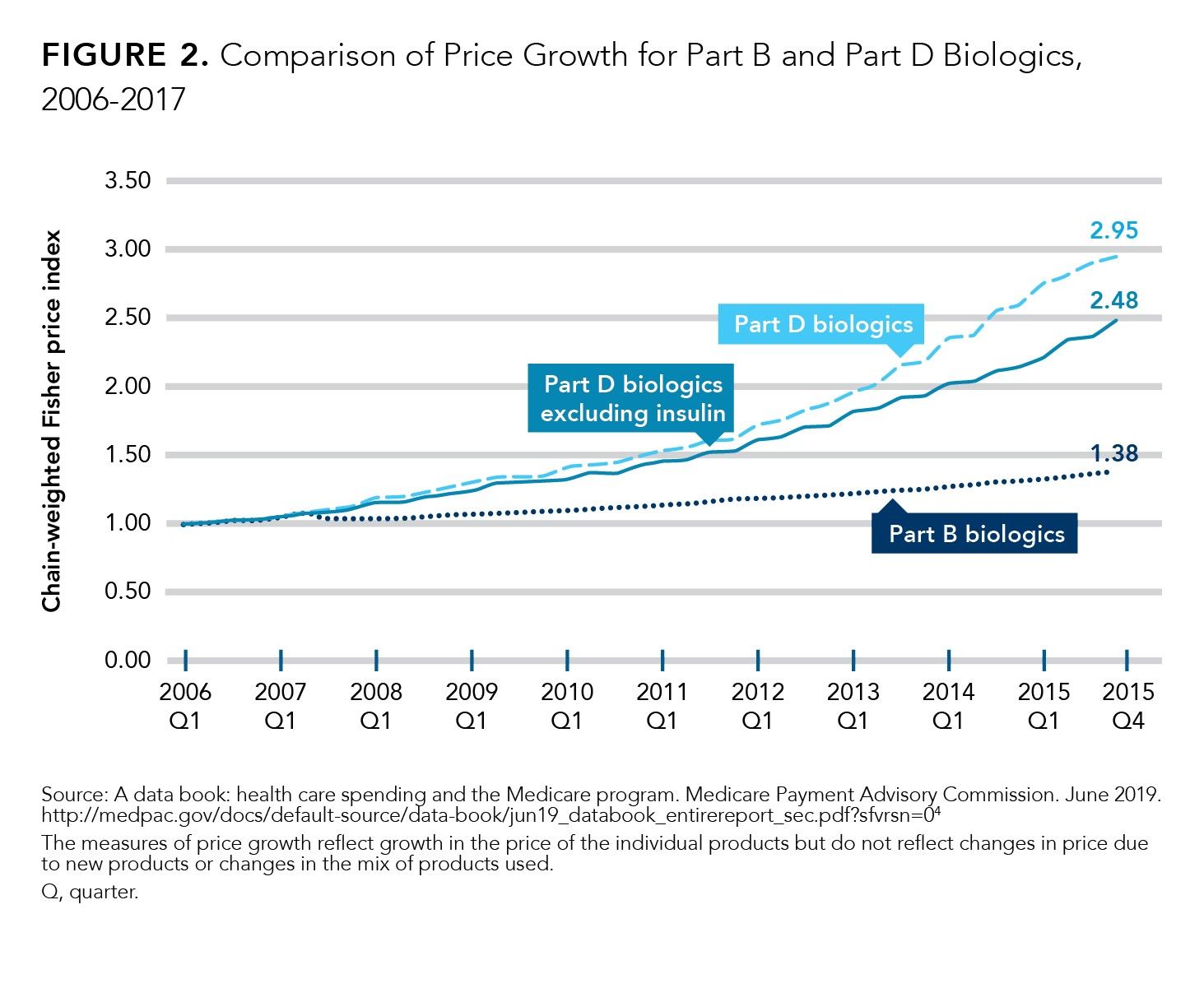
THE ASP PAYMENT METHODOLOGY AVOIDS PRICE SETTING BY GOVERNMENT AGENCIES AND ITS EXTENSIONS WHILE YIELDING MARKET-DRIVEN REIMBURSEMENT RATES NEAR OR AT ACQUISITION COST. In contrast to Part D, Part B reimbursement lacks gross-to-net issues, as value is eventually returned back to Medicare and patients. Gross-to-net issues exist when rebates and discounts are provided for high-cost drugs and then absorbed by pharmacy benefit managers (PBMs) or other intermediaries to off set part of the cost of nondrug treatments to reduce their patient premiums. This contract mechanism results in a large disconnect between the gross revenues and net revenues realized by drug manufacturers, increasing pressure on an already fragile system.29 Using ASP methodology allows Part B to avoid this issue and provides further evidence that moving Part B drugs to Part D, as proposed by the Trump Blueprint, would have presented new and larger problems.
THE ASP METHODOLOGY ELEGANTLY CREATES FINANCIAL RISK FOR THE PROVIDER THAT IS DIRECTLY PROPORTIONAL TO THE COST OF THE DRUG CHOICE AND NOT REPLICATED SO PRECISELY BY NUMEROUS ALTERNATIVE PAYMENT MODELS UNDER DISCUSSION. Physician incentive programs currently being explored, including shared savings, pay-for-performance, medical home, and those of accountable care organizations, present logistical issues: they are potentially difficult to understand and diffuse, and too far removed in time to be resilient reinforcements of individual physician behavior. In contrast, the ASP methodology and the risk associated with buy-and-bill or fee-for-service systems for providers are precise, tangible, immediate, and directly proportionate to the cost resulting from a clinical decision.29 Considering the lag time of ASP, there are several nuances for a provider to consider in terms of financing their practice.30 When a provider purchases a drug for a specific patient, they immediately incur the financial risk as a direct result of that decision. Under a standard transaction, they are reimbursed by Medicare reliably within 14 days of the claim submission, with subsequent supplemental insurance and patients to pay the balance. Major hurdles in accepting and sustaining this risk include needing the acquisition cost to be near or below the ASP, securing favorable financing terms to buy higher-priced drugs, installing an accurate claims-processing system, having near-perfect collection rates, incurring low to no price increases, and absorbing minimal overhead cost to execute the entire process. Because of these operational challenges, the driving incentive for physicians under ASP is not reward, but the avoidance of financial risk when using the most clinically attractive therapies for their patients.
In fact, rather than over reimburse for drugs, the current ASP methodology at times underpays. For example, in June of 2016, MedPAC reported an analysis of proprietary invoice data for 34 high-expenditure Part B drugs. Results showed that at least one-third of drugs sold to clinics were likely inadequately reimbursed.16
Further supporting this point, a recent publication analyzed the effective market price created by accounting for patient assistance program discounts of 18 ASP-based drugs. According to the results, ASP reimbursement exceeded the effective market price by more than 1% for only 5 of 18 drugs (range, 1.4%-7.8%). The illustrates the fact that despite a lower effective market price in some instances, ASP reimbursement methodology can maintain an appropriate reimbursement rate that is reflective of the market in the majority of cases.31
Minimal evidence exists to indicate that drugs are over utilized, with most never reaching their “brand-potential index”––in other words, the total number of patients who can receive the drug based on its indication(s). Furthermore, multiple publications have indicated that oncology practitioners are unlikely to change their treatment patterns or their decision to administer treatment to cancer patients, even when offered a higher reimbursement for using specific drugs.24,32
THE CURRENT ASP METHODOLOGY PROPERLY ALIGNS PHARMACEUTICAL PRICING BEHAVIOR IN THE DIRECTION OF PRICE INHIBITION BY INCLUDING MANDATORY REPORTING DOMAINS IN THE ASP CALCULATION. Although discounts and rebates given to intermediaries, such as PBMs, are not considered in the ASP calculation (because those price reductions are passed through subsequent entities), rebates and discounts given to purchasing providers through ASP are included. This results in lower reimbursement rates and savings to the Medicare program. As noted above, other activities that are deemed to reduce the purchaser’s cost are also included in the ASP calculation.6 This inclusion restricts the pharmaceutical industry from directly influencing drug selection through pricing mechanisms and provides a benefit to Medicare—and, ultimately, patients—via a lower reimbursement rate.
Impact on Generic and Biosimilar Use
THE PRESENT ASP METHODOLOGY INHIBITS SIGNIFICANT YEAR-OVER-YEAR BRAND AND GENERIC DRUG PRICE INCREASES. To understand this concept, it is important to note the 2-quarter lag between when sales occur and when the payment amount reflects those sales in the ASP methodology. This lag implies that price increases are absorbed directly by the provider for 6 months until the Medicare reimbursement rate for ASP is updated. Therefore, providers are required to purchase drugs with the possibility of inadequate drug reimbursement.30
This scenario is illustrated in Figure 3, which shows the impact of the 2-quarter lag on ASP reimbursement in a simplified version with an example drug. The WAC of the drug in Q1 2017 has been stable at $5500 and ASP-based reimbursement has also been stable at $5300. In Q3 of 2017, the example drug’s price increases to $7000 (as shown in the large red circle). Due to the 2-quarter lag in ASP-based reimbursement changes, the ASP 6 reimbursement does not “catch up” to the WAC until 2 quarters later in Q1 2018 (as shown in the smaller red circle). The risk of this scenario creates a natural inhibition to price increases for drugs dependent on Part B that is not easily overridden by manufacturers without rendering products commercially inviable.30
Figure 3.
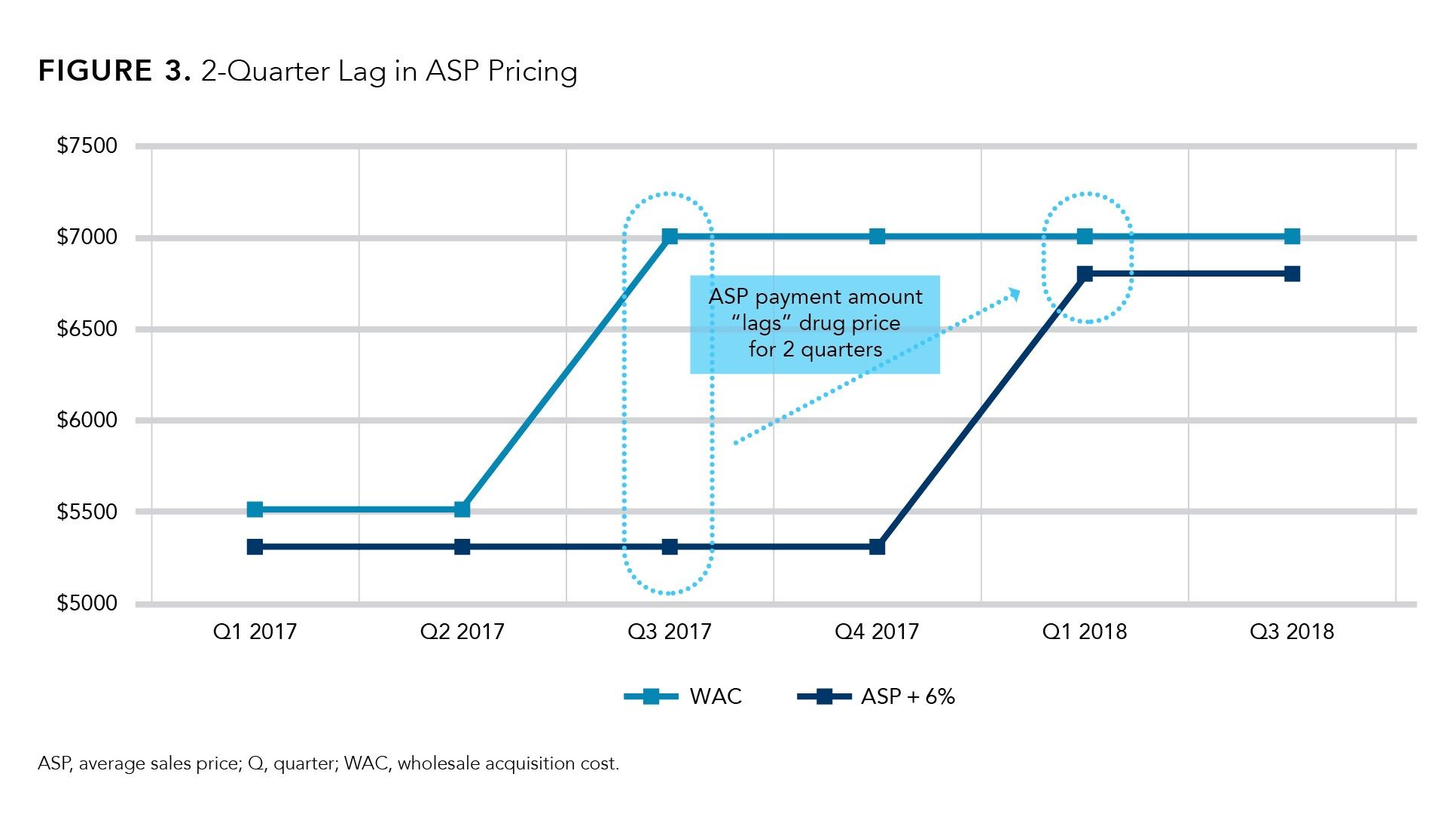
ASP METHODOLOGY ENGENDERS LOWER GENERIC DRUG PRICING RELATIVE TO BRAND INNOVATORS. Price increases are not immediately reflected in the ASP reimbursement, but price decreases, such as occur when a generic enters the market, are immediately apparent in a provider’s acquisition cost.30 Providers can then realize a potential increase in the actual reimbursement over acquisition cost proportionate to the price decrease enacted during the 6-month lag period.
For example, when a generic enters the market, it has an immediate reimbursement advantage if it is priced lower than the brand innovator. More often than not, the brand innovator is forced to react to the generic’s entry and lower its price. Over time, as multiple generic manufacturers enter the market, the ASP methodology continuously recalibrates at lower price points resulting from the discounts and rebates that competitors are placing in the market.
Due to the 2-quarter lag, there is always a proportionate advantage sequentially generated for the generic as the price spirals down. It is therefore not surprising that generic oncology drugs dependent on Part B reimbursement have quickly cannibalized their branded predecessors. Providers are incentivized to prescribe the generic over the brand due to its lower cost and reimbursement advantage, as depicted in Figure 4.
This ability of the ASP methodology to naturally spur lower generic drug prices is a hallmark of its success and is in stark contrast to that of the previous AWP system. However, the ASP methodology does more than lower the price.
Figure 4.
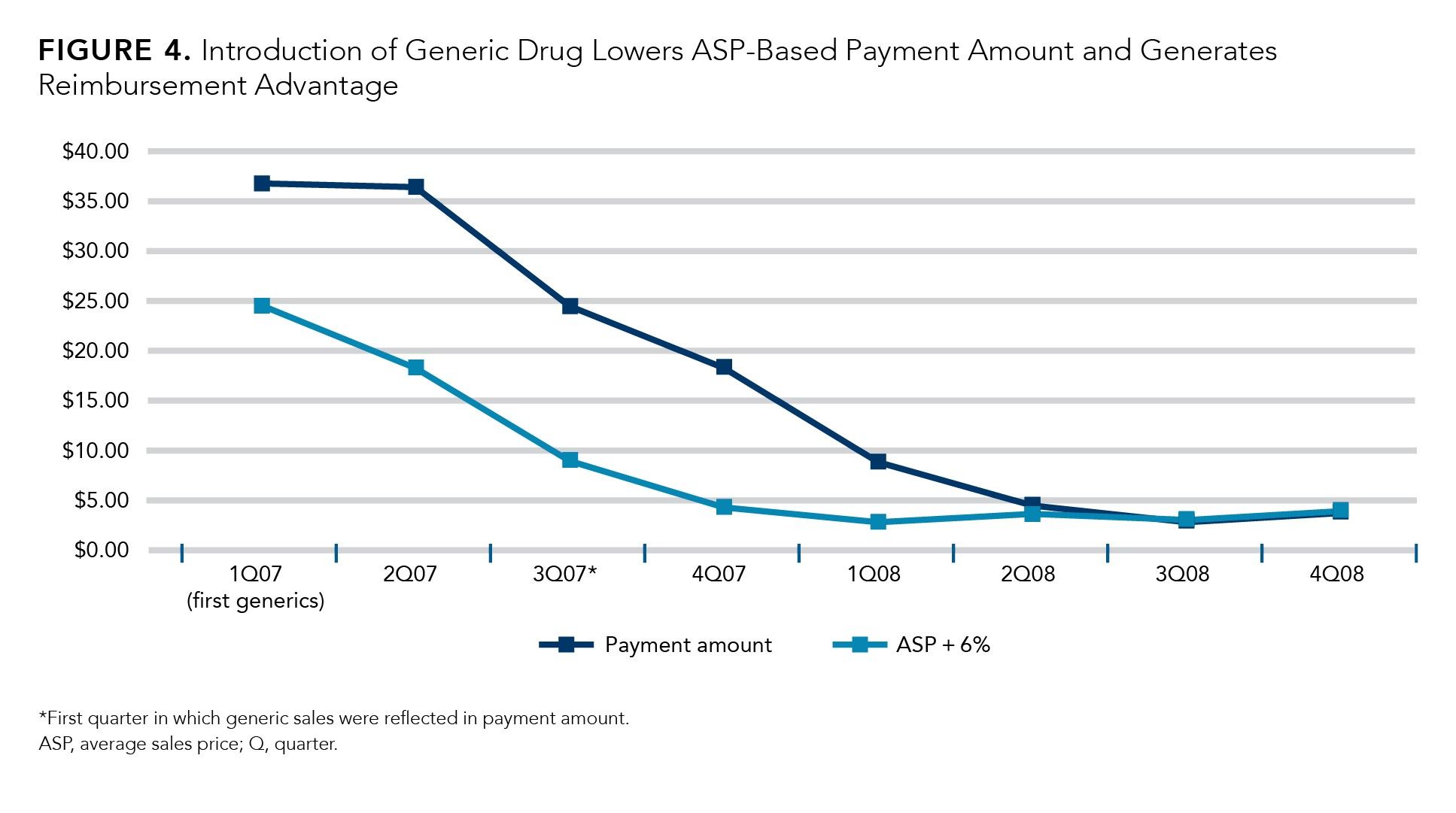
ASP INCENTIVIZES THE CONVERSION TO, AND CONTINUED USE OF, GENERIC DRUGS OVER THEIR BRAND INNOVATORS. In addition to the improved reimbursement that is proportionate to the price decrease during the 2-quarter lag, providers also have the benefit of a markedly lower risk of bad debt when using generics as opposed to the higher-priced brand alternative. Therefore, even if price increases are seen in generics, the risk of inadequate reimbursement (Figure 3) represents a more reasonable monetary value than that of previous brand innovators. From the outset of a generic’s introduction and resulting price decrease to its final lower price, the ASP methodology aligns Part B drug incentives for providers to use the lower-priced option and creates barriers for manufacturers to raise prices.30
CURRENT ASP METHODOLOGY ALLOWS FOR DIFFERENTIAL REIMBURSEMENT ADVANTAGES FOR BIOSIMILARS WHILE GENERATING LOWER PRICING. Just as ASP has created this situation for generics, it has likewise affected the biosimilar market. Similar to the addition of generics to the marketplace, the introduction of biosimilars is expected to lower prices.
According to the Patient Protection and Affordable Care Act, reimbursement for biosimilars will also be ASP plus 6%, but the 6% add-on is based on the innovator product’s ASP.33 This approach gives the biosimilar the advantage of a lower price with a proportionally larger add-on payment. Because of the benefits, described throughout this paper, inherent portions of the ASP methodology are worth preserving or imitating in future reimbursement methodologies.
Alternative Reimbursement Methodology
With the recent focus on drug price controls, such as the International Pricing Index Model, and criticism of the current ASP reimbursement method, we investigated alternative ASP-based reimbursement methods to determine whether they are worth pursuing. The objectives we desired with these alternatives included:
- Incentivizing the use of generics and biosimilars when available
- Continuing to support the sustainability of specialty practices of all sizes
- Supporting stability over time given changes in ASPs and drug mix, with Year 1 meeting at least ASP 6 in 2018
- Allowing providers to select appropriate therapies to meet individual patient needs
Methods
Current proposed alternative methodologies to ASP include cap models, tiered models, and value frameworks. Brief definitions of these strategies are provided in Table 1.
Table 1.
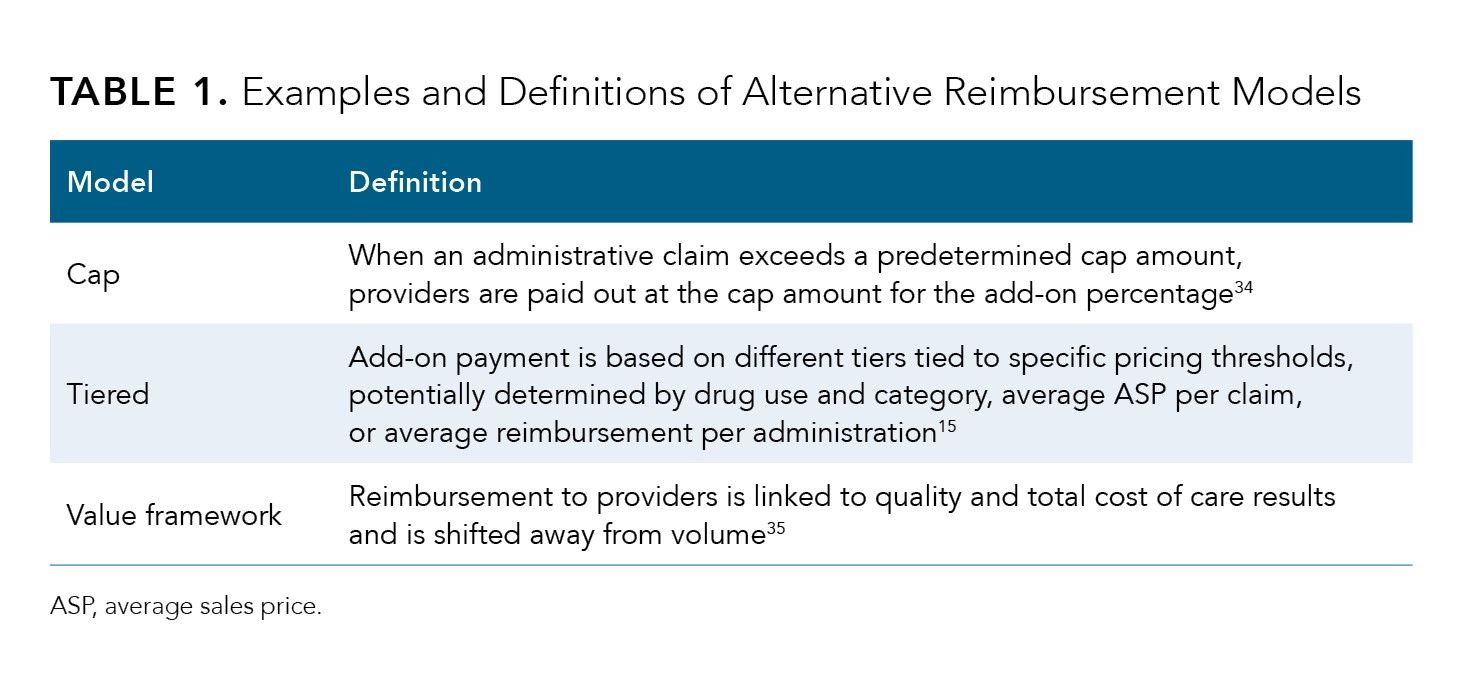
We used InfoDive, a strategic financial intelligence solution, to examine 101 practice sites of varying sizes that reported medical claims information on patients covered by Medicare or Medicare Advantage from January 2017 to June 2020. The patients saw a medical oncologist or hematologist within the observation period. The ASP for each drug was based on the Medicare ASP specific to the quarter in which the service was being rendered.
The methods we present here include ASP 6, ASP 4.3, and 2 alternative ones labeled “SD 3” (standard deviation) and “Fixed Tier.” The fixed tier method assigned tiers based on the maximum reimbursement per administration of a drug; the reimbursement add-on fee was dependent upon the claim’s tier. Similarly, the SD 3 method established thresholds utilizing the average ASP per administration claim and then considered standard deviations from that average. Depending on how many standard deviations from average, the claim was determined the thresholds applied and the reimbursement add-on. Details for these models are further illustrated in Table 2. Other tiered or capped models were evaluated but are not presented due to their failure to provide the
desired outcomes.
Table 2.
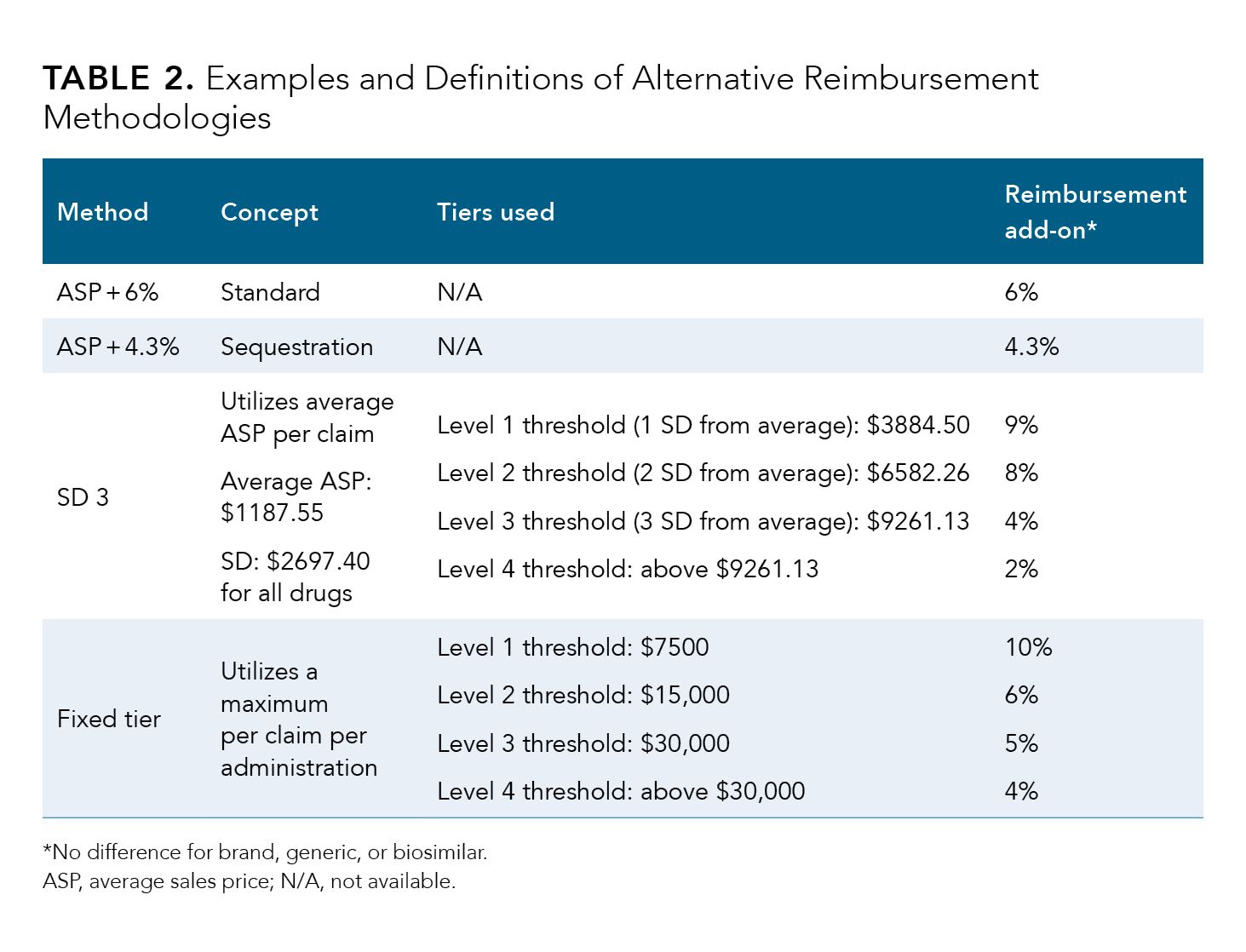
Results
The reimbursement based on the proposed methodologies for 2019 is shown in Figure 5. Both the SD 3 and fixed tier methods are at or slightly above ASP 6. Each model aff ected drug categories differently relative to ASP 6. The SD 3 model had the largest effect on the targeted therapy category, which represents some of the greatest costs of oncology care; the effect of the fixed tier model on these categories distributed the add-on to incentivize the use of lower-cost drugs, such as chemotherapy and supportive care. The effects of fixed tier and SD 3 models relative to ASP 6 are shown in Figure 6.
Figure 5.
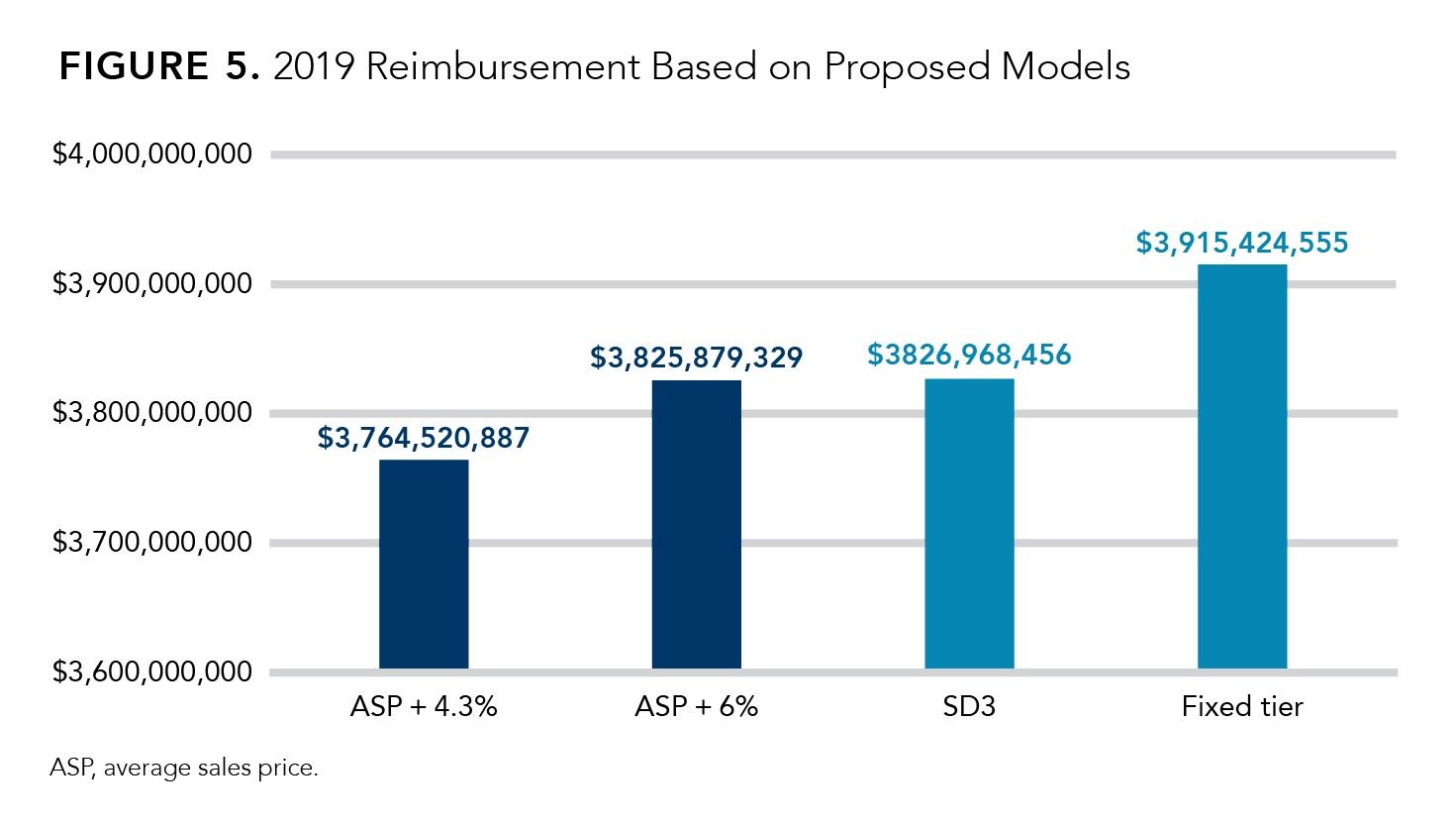
Figure 6.
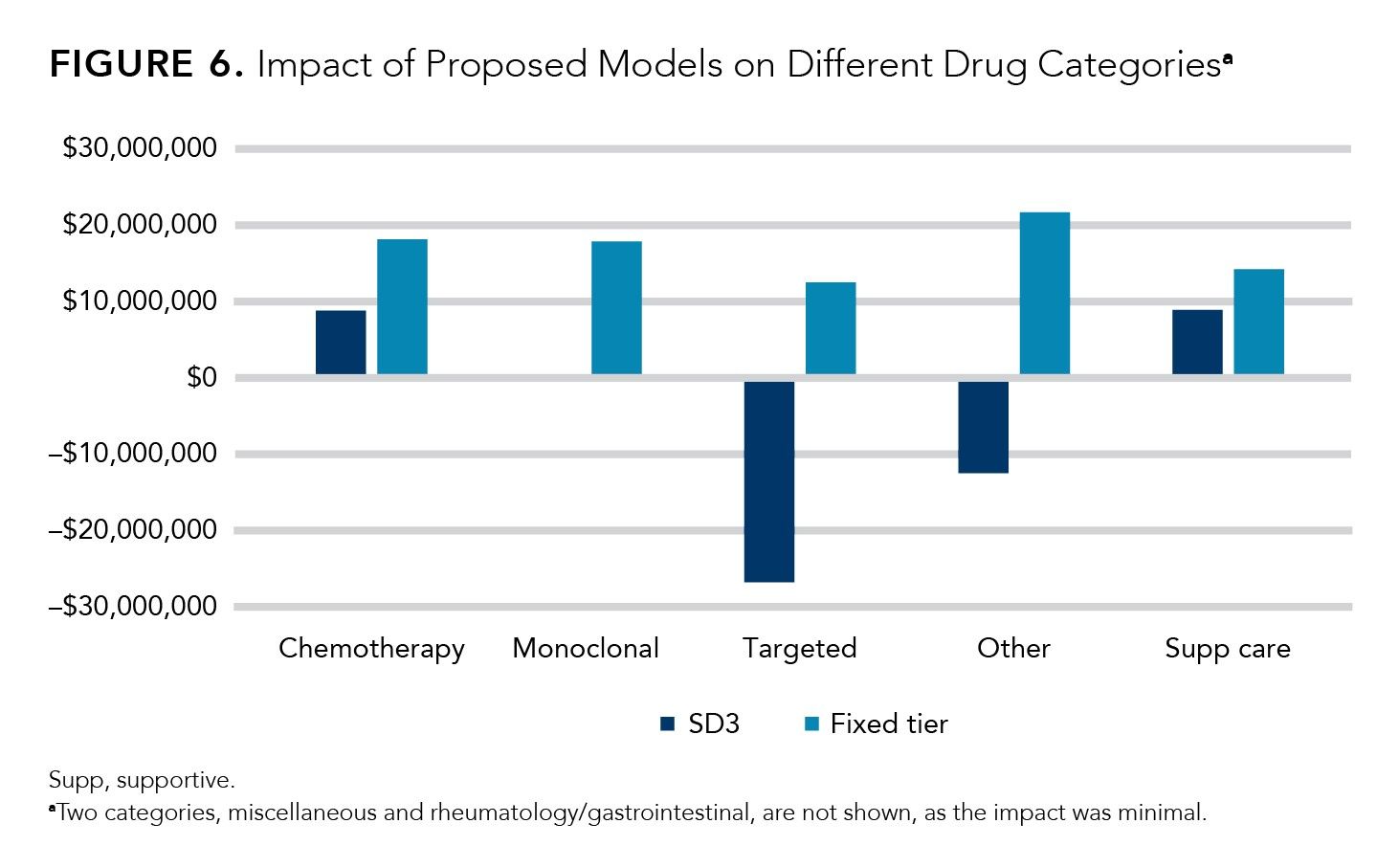
Practice settings were divided into 3 sizes: those with 5 or fewer medical doctors (MDs), those with 6 to 10 MDs, and those with 10 or more MDs. The models affected each practice size differently. The fixed tier and SD 3 models generated results similar to ASP 6. The average reimbursement per administration is shown in Table 3.
Finally, the impact of each model on the top 30 drugs based on total ASP and claim volume were evaluated. The results are shown in Table 4.
Table 3.
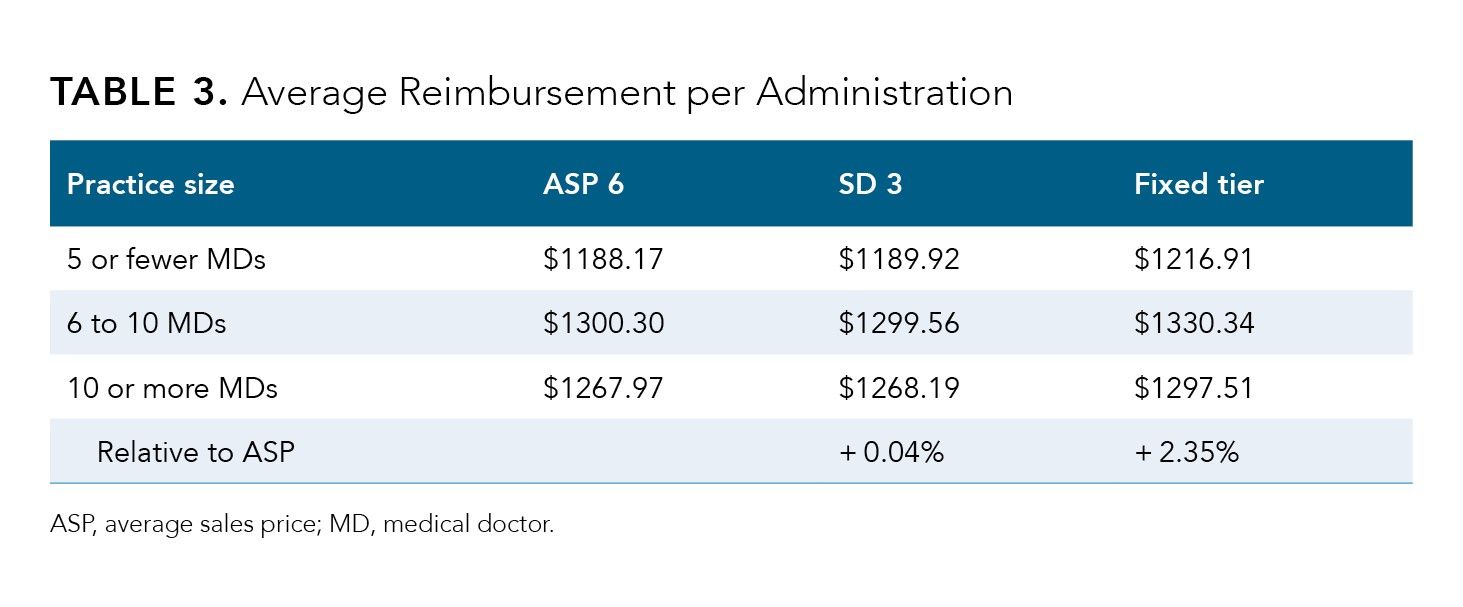
Table 4.
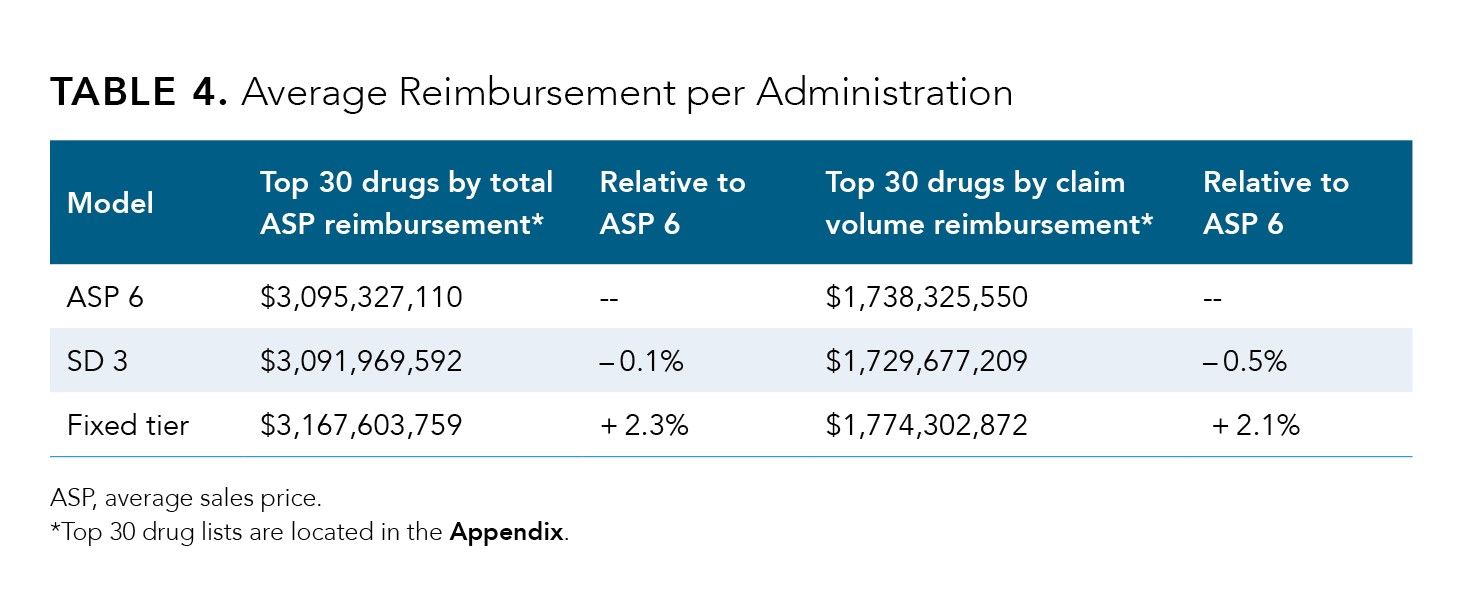
Future Directions
Our research showed that 2 alternative methods, 1 based on tiered reimbursement and 1 on average reimbursement and standard deviation, were able to provide the benefits of ASP 6, provide appropriate reimbursement to various sizes of oncology practices, and curb the growth rate of claims over time. These methodologies provide information for future methods that use ASP as their basis and build upon this construct to provide reasonable rates for payers and sustainability for practices of different sizes, ultimately resulting in optimal patient care.
Conclusion
Medicare Part B reimbursement using ASP methodology has qualities worth preserving in future systems. It has tempered the overall growth of Part B expenditures and met the demands of an increasingly cost-concerned society, as well as a defensive medical community and pharmaceutical industry. As the oncology community expects more value from drugs reimbursed through Part B, it is imperative to maintain the beneficial attributes of ASP and incorporate them into future reimbursement models. Otherwise, community oncology practices may no longer be able to acquire life-saving treatments during any given Medicare reimbursement period.
Incorporating a reimbursement model that engenders strong constraints rather than regulating absolutely allows for both patient and provider benefits. For the patient, such a model enables them, in conjunction with their provider, to remain a key stakeholder in determining clinical desirability weighed against financial risk. For providers, it allows the medical community to continue to align their desire for personalized or precision-based treatment, clinical experimentation, and clinical research with the multifaceted costs or savings of any given deviation from common standards by spreading the direct and indirect cost or benefit of a given variance across a range of participants. Despite the difficulty of experimental design in public policy–based research, it is imperative moving forward that decisions regarding changes to Medicare Part B reimbursement be based upon empiric data. Currently, actuarial evidence rather than population-based data is utilized to estimate changes in price trends and adjustments to reimbursement. Additionally, recent criticisms of ASP are generally based on theoretical models; they lack the incorporation of confounding factors such as the uptake of 340B drug pricing, continued changes in pricing, and orphan drugs launching at high prices but then expanding to additional indications.
Overall, ASP is a market-based tool that can be leveraged in the future to create a sustainable reimbursement model that is beneficial to patients, payers, and providers.
For Appendix, see:
www.ajmc.com/view/weidner-et-al-appendices
Author Information
Susan Weidner and Cass Schaedig are with IntrinsiQ Specialty Solutions, AmerisourceBergen in Carrollton, Texas. Michael Diaz, MD, and Lucio N. Gordan, MD, are on the board of Florida Cancer Specialists and Research Institute in Fort Myers, Florida.
CORRESPONDING AUTHOR: Susan Weidner, 5025 Plano Parkway, Carrollton, TX 75010. Susan.Weidner@Intrinsiq.com.
FUNDING: This work was funded by IntrinsiQ Specialty Solutions.
ACKNOWLEDGEMENTS: We would like to acknowledge Xcenda, LLC, for assistance with medical writing.
REFERENCES
1. CMS fast facts. CMS. July 2019. Updated March 12, 2021. https://www.cms.gov/research-statistics-data-and-systems/statistics-trends-andreports/cms-fast-facts/index.html
2. Chapter 2: The next generation of Medicare beneficiaries. MedPAC. June 2015. Accessed October 17, 2019. http://www.medpac.gov/docs/default-source/reports/chapter-2-the-next-generation-of-medicarebeneficiaries-june-2015-report-.pdf
3. Report to the Congress: Medicare and the health care delivery system. MedPAC. June 2019. Accessed October 17, 2019. http://medpac.gov/docs/default-source/reports/jun19_medpac_reporttocongress_sec.pdf?sfvrsn=0
4. A data book: health care spending and the Medicare program. MedPAC.
June 2019. Accessed October 17, 2019. http://medpac.gov/docs/defaultsource/
data-book/jun19_databook_entirereport_sec.pdf?sfvrsn=0
5. Kirkwood MK, Hanley A, Bruinooge SS, et al. The state of oncology practice in America,
2018: results of the ASCO practice consensus survey. J Oncol Pract. 2018;14(7):e412-e420.
doi:10.1200/JOP.18.00149
6. Medicare Prescription Drug, Improvement, and Modernization Act of 2003, Pub L No. 108-173,
177 Stat 2066 (2003).
7. Trends in weighted average sales prices for prescription drugs inMedicare Part B, 2006-2015. The
Moran Company. December 2016. Accessed October 17, 2019. http://phrma-docs.phrma.org/files/dmfile/Moran-Company_ASP-2015-Report_December-2016.pdf
8. Lang K. Medicare Monday:what is ASP? PhRMA Catalyst. September 28, 2015. Accessed
October 21, 2019. https://catalyst.phrma.org/medicaremonday-what-is-asp
9. Medicare Program; revisions to payment policies under the physician fee schedule and other revisions to Part B for CY 2019; Medicare Shared Savings Program requirements; Quality Payment Program; Medicaid Promoting Interoperability Program; Quality Payment Program-Extreme
and Uncontrollable Circumstance Policy for the 2019 MIPS payment year; provisions from the Medicare Shared Savings Program-accountable care organizations-pathways to success; and expanding the use of telehealth services for the treatment of opioid use disorder under the
Substance Use-Disorder Prevention That Promotes Opioid Recovery and Treatment (SUPPORT) for Patients and Communities Act. Federal Register. November 23, 2018. Accessed October 18, 2019. https://www.federalregister.gov/documents/2018/11/23/2018-24170/medicare-program-
revisions-to-payment-policies-under-the-physician-fee-schedule-
and-other-revisions
10. Report to the Congress: Medicare and the health care delivery system. MedPAC. June 2017. Accessed October 17, 2019. http://medpac.gov/docs/default-ource/reports/jun19_medpac_reporttocongress_sec.
pdf?sfvrsn=0
11. Ridley DB, Lee CY. Does Medicare reimbursement drive up drug launchprices? Rev Econ Stat. 2019;102(5):1-45. doi:10.1162/rest_a_00849
12. HHS blueprint to lower drug prices and reduce out-of-pocket costs. Federal Register. May 16, 2018. Accessed October 17, 2018. https://www.federalregister.gov/documents/2018/05/16/
2018-10435/hhs-blueprint-to-lower-drug-prices-and-reduce-out-of-pocket-
costs
13. Barlas S. Views conflict on Trump’s drug-pricing blueprint: most actions face political, legal, and technical roadblocks. PT. 2018;43(10):606-628.
14. LaPointe J. Potential Medicare reimbursement demo to lower Part B drug prices. Revcycle Intelligence. October 26, 2018. Accessed February 11, 2020. https://revcycleintelligence.com/news/potential-medicarereimbursement-demo-to-lower-part-b-drug-prices
15. Sullivan M, Brow M, Isaiah E. Is tiered provider reimbursement on the horizon for Medicare Part B? Avalere. June 13, 2019. Accessed February 11, 2020. https://avalere.com/insights/is-tiered-provider-reimbursement-on-the-horizon-for-medicare-part-b.
16. Payment Policy for Prescription Drugs under Medicare Part B and Part D, 2019, Hearing Before the Subcommittee on Health; Committee on Energy and Commerce (2019) (statement of James E. Mathews, executive director, Medicare Payment Advisory Commission). Accessed January 15,
2020. http://www.medpac.gov/docs/default-source/congressional-testimony/04_30_2019_medpac_drug_testimony_for_eandc.pdf?sfvrsn=0
17. Hornbrook MC, Malin J, Weeks JC, Makgoeng SB, Keating NL, Potosky AL. Did changes in drug reimbursement after the Medicare Modernization Act affect chemotherapy prescribing? J Clin Oncol. 2014;32(36):4042-4049. doi:10.1200/JCO.2013.52.6780
18. Conti RM, Bernstein AC, Villaflor VM, Schilsky RL, Rosenthal MB, Bach PB. Prevalence of off-label use and spending in 2010 among patent-protected chemotherapies in a population-based cohort of medical oncologists.J Clin Oncol. 2013;31(9):1134-1139. doi:10.1200/JCO.2012.42.7252
19. Report to the Congress: effects of Medicare payment changes on oncology services. MedPAC. January 2006. Accessed January 15, 2020. http://67.59.137.244/documents/Jan06_Oncology_mandated_report.pdf
20. O’Neil B, Graves AJ, Barocas DA, Chang SS, Penson DF, Resnick MJ. Doing more for more: unintended consequences of financial incentives for oncology specialty care. J Natl Cancer Inst. 2015;108(2):djv331. doi:10.1093/jnci/djv331
21. Jacobson M, Chang TY, Newhouse JP, Earle CC. Physician agency and competition: evidence from a major change to Medicare chemotherapy reimbursement policy. National Bureau of Economic Research. Accessed January 15, 2020. https://www.nber.org/papers/w19247
22. Jacobson M, Earle CC, Newhouse JP. Geographic variation in physicians’ responses to a reimbursement change. N Engl J Med. 2011;365(22):2049-2052. doi:10.1056/NEJMp1110117
23. Jacobson M, Earle CC, Price M, Newhouse JP. How Medicare’s payment cuts for cancer chemotherapy drugs changed patterns of treatment. Health Aff (Millwood). 2010;29(7):1391-1399. doi:10.1377/hlthaff.2009.0563
24. Jacobson M, O’Malley JA, Earle CC, Pakes J, Gaccione P, Newhouse JP. Does reimbursement influence chemotherapy treatment for cancer patients? Health Aff (Millwood). 2006;25(2):437-443. doi:10.1377/hlthaff.25.2.437
25. Chapter 5: Medicare part B drug and oncology payment policy issues. MedPAC. June 2016. Accessed October 17, 2019. http://www.medpac.gov/docs/default-source/reports/chapter-5-medicare-part-b-drug-andoncology-payment-policy-issues-june-2016-report-.pdf?sfvrsn=0
26. Medicare Part B: expenditures for new drugs concentrated among a few drugs, and most were costly for beneficiaries. Government Accountability Office. October 23, 2015. Accessed January 15, 2020. October 23, 2015. https://www.gao.gov/products/GAO-16-12
27. Colla CH, Morden NE, Skinner JS, Hoverman JR,Meara E. Impact of payment reform on chemotherapy at the end of life. J Oncol Pract. 2012;8(suppl 3):e6s-e13s. oi:10.1200/JOP.2012.000539
28. Weight CJ, Klein EA, Jones JS. Androgen deprivation falls as orchiectomy rates rise after changes in reimbursement in the U.S. Medicare population. Cancer. 2008;112(10):2195-2201. doi:10.1002/cncr.23421
29. Fein AJ. The gross-to-net bubble reached a record $166 billion in 2018 Drug Channels. April 3, 2019. Accessed January 15, 2020. https://www.rugchannels.net/2019/04/the-gross-to-net-bubble-reached-record.html
30. Medicare payments for newly available generic drugs. Department of Health and Human Services Office of Inspector General. January 2011. Accessed January 15, 2020. https://oig.hhs.gov/oei/reports/oei-03-09-00510.pdf
31. Medicare Part B: data on coupon discounts needed to evaluate methodology
for setting drug payment rates. Government Accountability Office. July 27, 2016. Accessed January 15, 2020. https://www.gao.gov/products/AO-16-643
32. Yasaitis L, Gupta A, Newcomb C, Kim E, Newcomer L, Bekelman J. An insurer’s program to incentivize generic oncology drugs did not alter treatment patterns or spending on care. Health Aff (Millwood).
2019;38(5):812-819. doi:10.1377/hlthaff.2018.05083
33. Patient Protection and Affordable Care Act, 42 USC §18001 (2010).
34. Holahan J, Blumberg L. Capping provider payment. The Century Foundation. January 5, 2018. Accessed January 15, 2020. https://tcf.org/content/report/capping-provider-payment/
35. LaPointe J. Understanding the value-based reimbursement model
landscape. Revcycle Intelligence. September 9, 2016. Accessed January 15, 2020. https://revcycleintelligence.com/features/understanding-the-value-based-reimbursement-model-landscape
